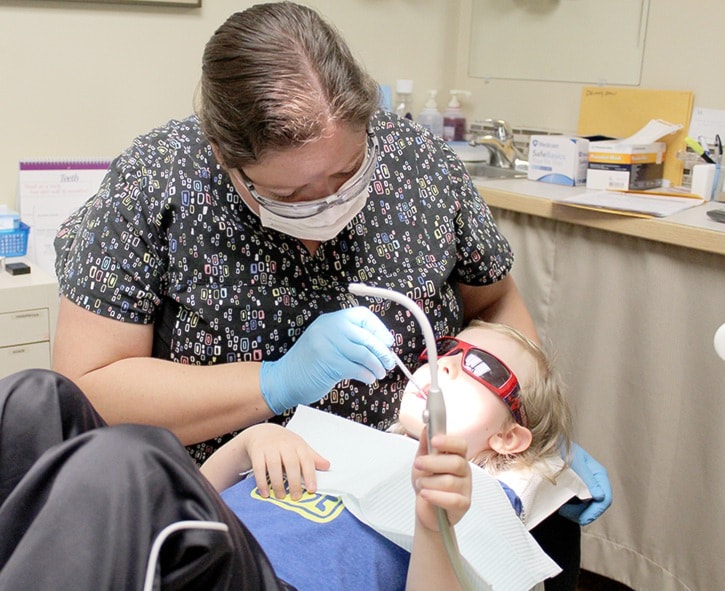Baby’s first tooth is a time to take photos and call grandparents. It’s also a time to start thinking about the dental care that can make a difference for the child for years to come.
“Children should have their first dental assessment by the time they are one year old,” said Laine Lowe, community dental hygienist and member of the board of directors of the Community Dental Access Centre. “People don’t think about the importance of dental care for baby teeth but baby molars don’t fall out until age 10 or 11. If the baby molars have cavities or abscesses and are gone earlier, the adult molars come in at the wrong location and cause bite problems and the need for orthodontics.”
Childhood dental problems can also affect speech development and proper nutrition.
Dental disease is the single most common chronic disease in children and the number-one reason children require general anesthetic in hospitals.
Lowe said there are three ways for a child to have a first dental health visit, with the family dentist, the free early intervention Lift the Lip Program through health units and the free Children’s Program at the Community Dental Access Centre. The Children’s Program is made possible by a grant from the Kal Tire Tom Foord Foundation.
“It provides early check-ups with staff dentist Dr. Tyler Sheasby, who likes working with kids, risk assessment and ongoing care, including fluoride varnish to reduce cavity risk. The grant allowed us to get child-sized equipment so we could offer this program. It is very important to have early dental care as cavities develop and can abscess very quickly in young children. About 25 per cent of children have cavities by age five,” said Lowe.
There is no fluoride added to water anywhere in the North Okanagan and a very small amount reduces the risk of cavity development.
“We had been wanting to offer the Children’s Program but did not have the equipment before. We are pleased to be able to offer this to the community with services not covered by the provincial Healthy Kids program. It is important for children to have their first dental visit early and experience it as something natural,” said Lowe.
Dr. Sheasby has been at the Community Dental Access Centre for about a year.
“I like to show kids the instruments and let them hold them. They can watch the dental process in a mirror on the wall. It can be challenging to work with children but it’s worth it to see those beautiful smiles and know that we are helping them have better dental health long-term,” he said.
The Community Dental Access Centre, run by a non-profit society, started in 2002 with a clinic opening in 2012. There is a staff dentist and volunteer dentists for people of all ages. Dental care is available to all low-income people in the North Okanagan with payment discounts based on income. The Angel Fund assists people with urgent dental care needs.
For more information, call 778-475-7779 or email info@communitydentalaccess.ca or see www.communitydentalaccess.ca. The clinic is at 3107c-31st Ave., Vernon, but call before visiting as clinic days vary.
Keeping smiles bright
- Cavities often start behind the front top teeth where they are not visible.
- Cavities in children start as white spots and develop quickly.
- Brushing should start with the first tooth.
- Up to age three, use a rice-sized amount of fluoride toothpaste.
- To age three to six, use a pea-sized amount of fluoride toothpaste.
- Parents should help children brush until the children are able to write (not print) their own names, usually about age eight.
- Brush twice a day. Parents should set example of brushing and flossing regularly.
- Make brushing fun with songs or stories or a timer.
- Choose healthy snacks like cheese, fruit or vegetables.
- Use water, not juice, for thirst.
- Avoid drinking anything but water constantly with a bottle or sippy cup, especially at night.
- Give juice, milk or other beverages with meal or snacks and limit access at other times.
